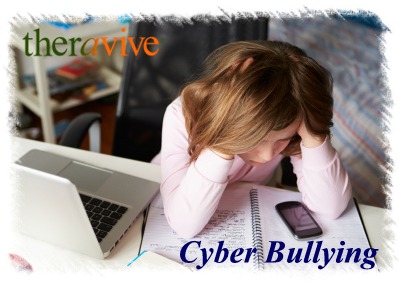Back to School Series:

Technology and the internet have changed how we communicate, how we learn, and how we take care of business. It has given us new ways to create, and experience the world around us. Unfortunately, some of the ways we have used technology to evolve are very negative. In the 2008/2009 school year, 20% of students experienced bullying by electronic means, and 28% experienced threat of violence through electronic means. [1] To protect our kids, we must be aware of cyberbulling, and how to prevent it.
What Is Cyberbullying
Cyberbullying is aggressive behavior that is unwanted, repeated, and involves a real or perceived imbalance in power that takes place on electronic devices or media, such as computers, cell phones, social media sites, text messages, chat, web sites, and online gaming. It is bullying between children, not adults. When adults get involved it becomes cyber-harassment, cyber-stalking, or sexual predator behavior.
How Is Cyberbullying Different Than Traditional Bullying
24/7- Cyberbullying can happen any time day or night. Although most cyberbullying is accompanied by in-person bullying, it is harder to avoid because it is not something you can remove or avoid.
Anonymously- Cyberbullying can be posted and distributed very quickly to a large audience, and can be hard or impossible to trace.
Permanent- Once something has been posted on the internet, it is difficult to have it removed.
By Proxy- Cyberbulling can be direct, or by proxy. Anyone can create a profile of the person being targeted to impersonate them and incite others. Others can then use bullying behavior because they think that the target started the behavior. It can be used as a means of punishment from parents, other kids, and even other groups. An example of cyberbullying that involves other groups is when someone posts on hate or sex sites and gives out personal contact information about the target.
Effects of Cyberbullying
Just like traditional bullying,(You can learn more about traditional bullying) kids who are cyberbullied are more likely to use alcohol and drugs, skip school, experience in-person bullying, are often unwilling to attend school, receive poor grades, have low self-esteem, and have more health problems.[2]
Prevent Cyberbullying
Parents and kids can work together to prevent cyberbulling by keeping lines of communication open.
- Talk to kids about what cyberbullying is and what to do if they see it.
- Establish rules about computer use, and keep the computer in an area of the house that has high visibility.
- Make rules with regard to device use so that parents are able to view all online activity and texts at any time. Reassure kids that, as a responsible parent, it is about safety, not invading their privacy. Installing software to monitor online behavior is helpful, but not as effective as monitoring personally.
- Know the sites your child visits, who they are with and what they do online.
- Follow your kids on social media, and get a feel for the web sites they use.
- Teach kids about online safety, such as what to post and how someone may perceive their posts and activities. Only “friend” real friends. Teach them how to know who can see and how to control who can see their posts and activities. Never share user-names, passwords, or location on any web sites.
What To Do If You See Cyberbullying
- Never respond to or forward cyberbullying, but do keep any evidence of cyberbullying. Be sure to capture dates, times, and descriptions of cyberbullying by printing screenshots, email or text messages. You can use this record to report to the proper channels.
- Block the person doing the cyberbullying.
- Look for terms of service for the media, and follow their instruction for reporting so that they can take action.
- Report cyberbullying to law enforcement whenever there are threats of violence, child pornography, or explicit messages or photos, stalking, or hate crimes, or if a picture is posted of someone in a place that they would expect to be private.
- Let schools know about the bullying. Often times, schools cannot take action directly, but they can help by being aware of the situation. Also, some states require that schools have anti-bullying policies included in the schools handbooks so that it is contractual, and they can take action.
- Counseling can help both parents and kids with the stress of cyberbullying.
[1] "Student Victimization in Schools." National Center for Education Statistics (NCES) Home Page, a part of the U.S. Department of Education. Institute of Education Sciences, Nov. 2011. Web. 4 Aug. 2013.
[2] "What is Cyberbullying | StopBullying.gov." Home | StopBullying.gov. N.p., n.d. Web. 4 Aug. 2013.
[3] http://www.dosomething.org/tipsandtools/11-facts-about-cyber-bullying